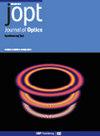向列液晶实现的电磁诱导透明双模到单模转换
IF 2.7
4区 物理与天体物理
Q3 OPTICS
引用次数: 0
摘要
本文提出了一种在千兆赫(GHz)波段圆偏振(CP)波作用下的CP元结构(MS)。近年来,向列液晶(NLC)备受关注,但要在 NLC 的控制下实现电磁诱导透明(EIT)的双模变单模仍有困难。通过金属交叉谐振器、金属环谐振器和介质交叉谐振器的直接相互耦合,可以形成模耦合并产生透明窗口。通过外加偏置电压(Vbias)调节 NLC,可以观察到两种不同的 EIT 状态(单模和双模 EIT),并伴有慢光效应。当 Vbias 为 0 V 时,可在 6.595-8.443 GHz 和 8.443-10.161 GHz 频段实现两个透明窗口。当 Vbias 为 20 V 时,在 6.891-8.682 GHz 频段只能实现一个透明窗口。由于具有高度对称性,MS 对 CP 波具有极化不敏感性。这些极其优异的特性使得这种 MS 具有广泛的应用前景。值得注意的是,EIT 的理论计算结果通过双振荡器理论模型和电路模型进行了验证,得到的结果与仿真结果基本一致。本文章由计算机程序翻译,如有差异,请以英文原文为准。
Electromagnetically induced transparent bimodal to unimodal conversion realized by the nematic liquid crystal
In this paper, under the action of a gigahertz (GHz) band circularly polarized (CP) wave, a kind of CP metastructure (MS) is proposed. Recently, the nematic liquid crystal (NLC) has received great attention, but it is still difficult to realize the electromagnetically induced transparency (EIT) bimodal to unimodal under the control of NLC. Through the direct mutual coupling of the metal cross resonator, metal ring resonator, and dielectric cross resonator, modes coupling can be formed and generate transparent windows. Two different EIT states (unimodal and bimodal EIT) accompanied by slow light effects can be observed by regulating the NLC with the applied bias voltage (Vbias). When the Vbias is 0 V, two transparent windows can be achieved in the 6.595–8.443 GHz and 8.443–10.161 GHz bands. When Vbias is 20 V, only one transparent window can be achieved in the 6.891–8.682 GHz band. Due to the high symmetry, the MS has the polarization insensitivity to CP waves. These extremely excellent properties make this MS have a wide application prospect. Noteworthy, the theoretical calculation result of EIT is verified by the two-oscillator theory model and circuit model, the results obtained are basically consistent with the simulation results.
求助全文
通过发布文献求助,成功后即可免费获取论文全文。
去求助
来源期刊

Journal of Optics
OPTICS-
CiteScore
4.50
自引率
4.80%
发文量
237
审稿时长
1.9 months
期刊介绍:
Journal of Optics publishes new experimental and theoretical research across all areas of pure and applied optics, both modern and classical. Research areas are categorised as:
Nanophotonics and plasmonics
Metamaterials and structured photonic materials
Quantum photonics
Biophotonics
Light-matter interactions
Nonlinear and ultrafast optics
Propagation, diffraction and scattering
Optical communication
Integrated optics
Photovoltaics and energy harvesting
We discourage incremental advances, purely numerical simulations without any validation, or research without a strong optics advance, e.g. computer algorithms applied to optical and imaging processes, equipment designs or material fabrication.
 求助内容:
求助内容: 应助结果提醒方式:
应助结果提醒方式:


